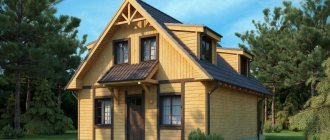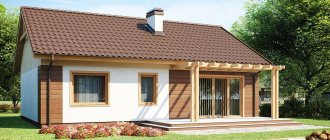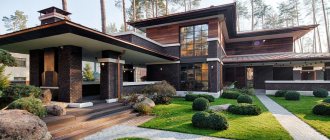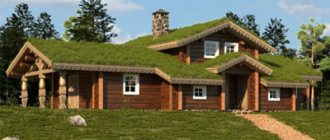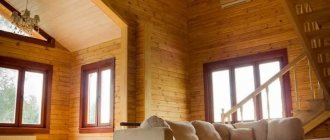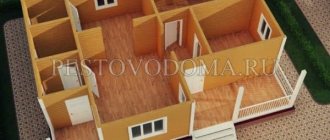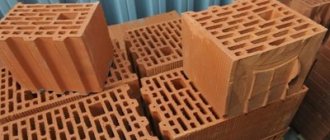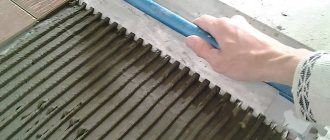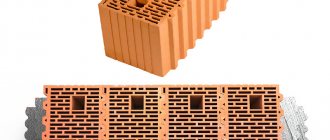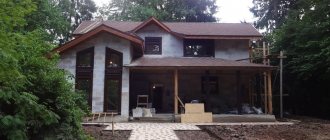Many people dream of a private home, because they so want to escape from the bustle of the city. But a private house is an expensive pleasure, which is due to the rising cost of building materials. Brick, natural wood, and stone are becoming increasingly unavailable for individual construction, so representatives of the construction industry and their clients were forced to search for more economical materials with similar characteristics. And they were found! High-quality, relatively light gas silicate
Today they are widely used for commercial and private construction.
Houses built from aerated concrete have an attractive appearance
, they
are resistant to temperature changes
, so they can be erected in regions with any type of climate. It is cool in such houses in summer and very warm in winter, so owners of aerated block houses will feel comfortable!
Houses have a number of characteristics, in some cases their quality exceeds the quality of buildings built from brick or wood. The porous structure of the material is the key to excellent thermal insulation
, resulting in good savings on heating costs. Gas silicate used in individual construction can be combined with other materials, which improves its performance characteristics.
Home selection
What is the best material to choose?
First you need to figure out what aerated concrete is and what aerated silicate is, and whether there is a difference. These materials belong to varieties of concrete and differ only in manufacturing technology, but have the same characteristics.
Gas silicate is aerated concrete, which may not contain cement at all, or may be present in small doses. A silicate mixture is used for the binder.
Aerated concrete is made from cement, water, lime and quartz sand . Both compositions undergo the same technological process. To form pores in materials, paste or aluminum powder is used. Non-autoclaved concrete is produced using old technology.
The difference in name (gas silicate or aerated concrete) refers to the material used to create the product. According to the new standard, autoclaved concrete does not require marking of the binder composition, so it is more correct to call this type “aerated concrete.” It is worth noting that in practice the same product can be called differently.
Autoclaved and non-autoclaved aerated concrete
Autoclaved concrete has a number of advantages:
- made using special technology, it is more durable;
- has soundproofing qualities;
- has less weight compared to other concretes.
The main disadvantage of autoclaved concrete is its great fragility.
Although non-autoclaved concrete is of lower quality, it also has some advantages. It absorbs less moisture and is cheaper.
When choosing a material for construction, you need to know a number of parameters . Density: the strength and thermal insulation characteristics of gas silicate depend on it. Blocks with a density of 500 kg/m3 are considered suitable for the construction of low-rise buildings.
Durability: this parameter depends on the quality of production. Good quality means the minimum amount of defects found in the purchased blocks. Ease of processing: it is easier to finish walls using gas silicate than brick.
Dimensions
When choosing the size of gas silicate blocks for building a house, you need to decide on the thickness of the wall (we'll talk about this below): an external wall with a thickness of, for example, 400 mm. can be placed either in one row or in two rows of 200 mm each. Here are the standard block sizes most commonly found on the market:
- Block width for external walls: 200, 250, 300, 350, 375, 400, 500 mm, for internal partitions: 100-150 mm.
- Length: 600, 625 millimeters.
- Height: 200, 250, 300 mm.
When choosing a material for building a house from gas silicate blocks, remember frost resistance . With strong temperature changes, intensive wear of the material occurs.
It would be a good idea to look at the product recipe. Remember, the more cement there is in the blocks, the less moisture it will absorb. When purchasing aerated concrete, you need to let it rest.
Gas silicate blocks have a service life of up to 100 years in a suitable climate and 50 in a humid climate.
A little history
Aerated silicate block D400
Despite the fact that construction from aerated concrete in private households is just beginning to gain popularity, the history of this material goes back more than a hundred years. The first documented successful experiments in creating porous concrete date back to 1889. The father of the prototype of modern gas silicate blocks was the Prague pharmacist E. Hoffman. By mixing lime flour with diluted hydrochloric acid, he obtained a gypsum solution, which, after hardening, retained a porous structure. However, at that time the invention did not find wide practical application.
A quarter of a century later (1914), J. W. Oulsworth and F. A. Dyer recommended using hydrogen released during the chemical reaction of lime, water and metal powder (zinc or aluminum) as a “porogenizer.”
The most significant contribution to the study and development of the production of cellular concrete was made by the Swedish industrialist A. Eriksson. It was he who proposed adding quartz sand to viscous lime and metal powder, and hardening was carried out under high steam pressure (1.0 MPa). This production method was adopted as a basis in 1929. They also initiated the modification of the working composition by adding quartz flour/sand and Portland cement to it (1933).
At the same time (1934), the Swedish company began producing aerated concrete without the use of lime flour, replacing it with Portland cement and ground sand.
In the post-war years, when the need for building materials increased tenfold, much more attention was paid around the world to the study and improvement of the production of porous concrete. In the Soviet Union, the production of nuclear fuel reached an industrial scale by 1950–1960. The scientific and experimental achievements of Soviet scientists were in many ways ahead of the work of their foreign colleagues. By 1980, more than 250 million m2 of residential buildings and structures made of aerated concrete had been built.
Advantages and disadvantages
The main reason for choosing this type of blocks for construction is their relatively cheap cost.
According to estimates, one square meter made from blocks is half as expensive as one made from bricks .
Many who built it claim that this is not entirely true. Since the material is quite fragile, there is a lot of fighting going on.
The cost of construction also increases due to the outer cladding of the walls. Without this it will not work, since gas silicate easily absorbs water and begins to collapse.
Not every material is suitable for wall covering . Siding is best suited for this purpose; you can line the walls with facing bricks, but this will increase the cost of construction. With dry cladding, you will need a gap for ventilation to prevent mold from appearing in the house.
When advertising their product, gas silicate manufacturers say that houses made from it will be warm and construction will not take much time. Is it so? The house will be warm, but then the walls will need to be protected from moisture.
Much depends on the geometry of the blocks; with an error (1 mm per 600) it will be easy to build a house . This quality of material can only be created by reputable gas silicate manufacturers, and the products will not be cheap.
When building a house, you should not skimp on mortar; glue for blocks retains heat better. The blocks are heavy and impossible to handle alone, but they are easier to process than bricks.
When building a house from aerated concrete, consider the following points:
- Do not build higher than two floors, the walls may not withstand the load.
- Make a metal mesh frame for each floor.
- The house requires a monolithic foundation.
- Remember that the walls will shrink.
In houses made of gas silicate it is easy to carry out electrical wiring and install heating. If you do everything wisely, the house will turn out warm, beautiful and built in a short time; you can move into it in less than a year.
An aerated block is 14 times larger than a brick. Building a house from blocks takes less time.
Let's compare the parameters:
- costs less than a brick;
- gas silicate is warmer than brick;
- The blocks have better thermal conductivity;
- Frost resistance parameters for aerated concrete are 50 cycles, for brick 80-100.
Flaws :
- low compressive strength;
- water absorption, the need to prime the facade.
Mortar for thin joint masonry
Assembly adhesive is used as a connecting solution. Thin-seam masonry involves applying a 3-4 mm layer of glue to the horizontal sides of the slabs - this is enough for a strong connection (the thickness of the seam after installing the blocks will be only 2 mm).
Some features of working with the solution:
- to prepare the adhesive solution, use the dry mixture, which is sold in 25 kg bags;
- to get a high-quality solution, strictly follow the instructions on the package - it indicates the required volume of water and mixing time;
- mix the amount of solution that you can use in 50–60 minutes;
- The average consumption of dry mixture is 2 bags per cubic meter of masonry.
You can also prepare the solution yourself. Mix a bucket of tile adhesive and half a kilogram of PVA to obtain an elastic, fine mixture.
Wall thickness
The optimal thickness of the walls of a block house must be agreed with SNiP. The use of gas silicate is strictly regulated:
- We need to calculate the height of the walls.
- Height restrictions are 4-5 floors.
- For three-story houses, the blocks must be grade B-2.5.
For summer living, adhere to the following rules:
- Use blocks with a thickness of at least 200 mm.
- Two or three storey houses are built from blocks 300-400 mm thick.
- The partitions are erected from gas silicate with a thickness of 200-300mm.
For year-round living in central Russia, the thickness of the blocks is 375 mm. brand D400.
All parameters can be calculated using special formulas. Correctly made calculations will ensure a sufficient level of strength and resistance to your home under any loads.
In the Middle Zone, the thickness of a gas silicate wall is:
- Block density 400 kg/cub.m. the wall must be at least 44cm thick.
- At a density of 500 kg/cub.m. wall thickness 37.5 cm.
Workspace organization
It is necessary to think through an action plan in advance and strictly adhere to technical construction requirements. For example, you need to draw up a construction organization project (CAP) in advance, which will indicate the sequence of wall construction.
Also consider the following points:
- install scaffolding at a level of 60–90 cm above the floor to reduce physical stress during work;
- leave openings in the leveling layer if you plan to use a mini-crane;
- organize the space in such a way that equipment can move parallel to the wall being built.
By following these simple recommendations, you will be able to efficiently construct the partitions and walls of the building on your own.
Do-it-yourself technology
Masonry
Before laying the blocks on the foundation, you need to install waterproofing. This can be roofing felt or bituminous material.
In a ratio of 1 to 3, apply sand-cement mortar to the waterproofing . We pay special attention to the first row of gas silicate. We place the block on the mortar, align it vertically and press it horizontally, tapping it with a mallet.
We lay it down, bandaging the previous row by 15-20 cm, the bandage should run exactly half the length of the silicate block. In hot weather, wet the wall.
We start laying from the corners, pull the cord and lay out a row. Don't forget about openings. Every four rows we make reinforcement. We connect each last row of the floor with an armored belt made of red brick.
We reinforce the masonry on the first row and every four rows . It often happens that not whole blocks are needed. Aerated concrete cuts well, so no problem.
Openings (doors, windows)
The blocks cut well. The corner device allows you to make a perfect cut; you need to fulfill one condition: the aerated concrete must be at least 15 cm long. Plus, the cheapest manufacturing method.
Several methods are used to create openings. The impact method is done with a jackhammer. This type of work should only be done by a specialist. The non-impact method, using diamond cutting, allows you to accurately make an opening.
The best way is to clearly plan the openings when building a house and strictly follow the markings.
Partitions
For partitions, the industry produces gas silicates of smaller thickness . The standard for such blocks is 100-150 mm, brand D400. Before creating a partition, it is necessary to accurately mark all the parameters. A laser level is best suited for this.
After marking the floor, waterproofing is done. To reduce cracks and for sound insulation, vibration-damping material is laid. To better connect the walls, metal plates are placed in the masonry seams.
The partition is done as follows:
- Make a cement screed 10 cm thick.
- Mark the walls and ceiling.
- They make a temporary frame.
- Clean the walls and ceiling from dust.
- A layer of glue is placed on the screed, the block is put in place, leveled using a fishing line stretched between the posts of the temporary frame, glue is applied to the bottom row, each row is shifted by half of the block for tying.
Jumpers
They make lintels to enhance the strength of cottages and low-rise buildings. This makes it possible to distribute the loads and get rid of cracks in the opening area.
When using a U-shaped design, the installation of the jumper is simplified. The most reliable and simplest option is to install silicate on the jumpers from the corner, cutting them into the block.
Let's consider different options. Reinforced aerated concrete lintels are made for houses no higher than 17 m. Such beams are light in weight, have no “cold” elements, are quickly installed, and are well processed. The downside is the price.
Reinforced concrete floors are made of concrete and iron rods. Plus low price.
Wooden lintels are treated with an antiseptic; you can make them yourself ; they are well processed and light weight. Minus: short service life.
Metal profiles have good characteristics, but are susceptible to corrosion. Need painting and fixing. Monolithic concrete beams can withstand heavy loads, but are labor-intensive to manufacture.
Interfloor armored belt
To give stability to a building, a reinforcement frame is needed. Every home has problem areas that need to be strengthened:
- between the foundation and the first row of masonry;
- the surface of the main walls that receives the mass of the roof;
- openings of doors and windows.
The formwork panels are attached to the walls with self-tapping screws. Spacers are made from timber along the width of the armored belt at a distance of 1.5 meters from each other. Twist the boards with wire, pressing them tightly against the spacers.
The armored belt is reinforced with a 12 mm frame . rods connected with wire. Place the frame in the formwork and fill it with mortar. You need to fill it in one go.
The armored belt, creating a stiffening rib in a gas silicate structure, prevents the structure from collapsing. Such a monolith stabilizes deformation in walls with heterogeneous loads.
Manufacturers in the Russian Federation
In Russia there are many small enterprises and large factories that specialize in the production of gas silicate blocks. Among them there are 5 companies:
- " Bonolit ". The plant is located 22 km from Moscow in the city of Staraya Kupavna. The manufacturer has its own technology for manufacturing products, which is carried out using modern and high-tech equipment. All work processes are automated and regulated by highly qualified specialists. The price for 1 m3 of elements is from 3,500 rubles.
- " Aerobel " (Belgorod). The price for 1 m3 can start from 3200 rubles. The quality of the products presented in the catalog corresponds to reality. Such blocks are ideal for laying buildings up to 5 floors.
- " Pridonskaya VKSM " (Voronezh). The price for 1 m3 reaches 3290 rubles. The manufacturer guarantees that its products comply with building standards and environmental standards. The blocks are produced in various variations in size and technical parameters.
- " LSZ " (Lipetsk). The plant has been operating since 1938. The price per 1 m3 is 3,300 rubles. The elements are processed immediately before autoclaving. This reduces equipment wear, eliminates the need for additional transportation and prevents dust formation during processing.
- " Bikton " (Volzhsk, Mari-El Republic). The plant produces approximately 380,000 m3 of blocks per year. The elements have precise geometric dimensions and are available in densities starting from D350. The cost of 1 m3 is from 3450 rubles.
What to look for when purchasing?
Before purchasing gas silicate material, you need to decide what they will be used for. If these are load-bearing walls, especially in multi-storey buildings, then you need a material with a density higher than D500.
For the construction of non-load-bearing walls and as wall insulation, elements with a density higher than D300 are suitable.
When choosing a material among products of the same price category, it is worth remembering:
- For load-bearing structures it is better to purchase more expensive material. This way there is a greater chance that the gas silicate will be of high quality and durable.
- For interior walls, partitions or non-essential structures (outdoor shower, bathroom, garage, bathhouse), you can purchase cheaper material.
Features of operation of country houses
Country houses are operated in a special regime. Unlike residential buildings, where people are constantly present, on average they come to the dacha once or twice a week. This creates special operating conditions for the walls, which most of the time are practically unused in the house, and when people are present they begin to work as the walls of a living space.
A difficult situation arises when wall materials constantly change their state. When people are present, the internal air becomes oversaturated with water vapor. It is absorbed into the walls, gradually changing their humidity. Under normal conditions, steam saturates the entire wall and evaporates outside. At the same time, the solid wall does not become wet, its humidity simply increases slightly.
In the summer, periodic visits to the dacha do not create any problems. While there are no people, the walls dry out and the material is in normal conditions. However, in the autumn or spring, when it is warm during the day and frosts occur at night, moisture can freeze, posing a threat to the walls of destruction. Periodically visiting the house increases the threat, as the moisture inside the outer layer of the walls freezes and traps steam inside the structure. People breathe, cook food, light the stove. All these actions increase the amount of steam that is absorbed into the walls and cannot escape outside. The amount of moisture accumulates, the walls begin to get wet and gradually collapse.
A country house made of aerated concrete is highly susceptible to this danger. The material is hygroscopic, its water absorption according to GOST is 12% (and in practice it can be much higher due to difficult external conditions). If you do not take appropriate measures, you can quickly get wet and destroy the walls.
The main way to combat walls getting wet from the inside is to apply a high-quality vapor barrier layer. You can paint the walls with moisture-resistant paint, stick on impenetrable wallpaper (vinyl or other synthetics). At the same time, it is imperative to organize high-quality supply and exhaust ventilation in the house, otherwise all the activities will be of no use.
Composition of aerated concrete
The composition of the material differs from traditional dense concrete in the presence of special gas-forming components:
- Portland cement;
- sand;
- quicklime;
- gasifier (aluminum powder);
- water.
Aerated concrete is produced by different manufacturers who add their own additives to the material. Sometimes they make gas blocks stronger and more durable; sometimes less successful additions occur. Often waste from metallurgical production or ash from thermal power plant furnaces are used. These additions change the color and appearance of the material.

